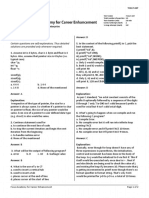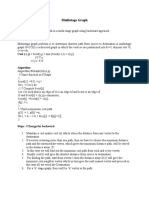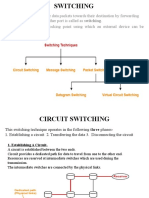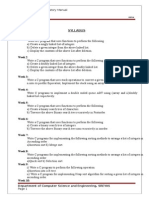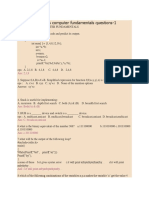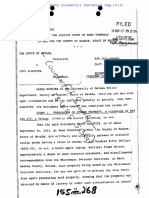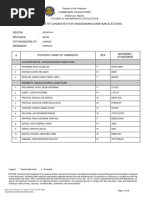Timestamp Based Protocol
Uploaded by
Anjali Ganesh JivaniTimestamp Based Protocol
Uploaded by
Anjali Ganesh JivaniConsistency & Concurrency
Timestamp-Based Protocol & Thomas Write Rule
Timestamp-Based Protocol:
Serializability is decided as per the timestamp of a transaction (Time when a transaction starts) Timestamp is based on system clock or a logical counter Each data item Q has two timestamps: W- TS(Q) largest TS of transaction that executed W(Q) successfully R-TS(Q) largest TS of transaction that executed R(Q) successfully This protocol implements conflict serializability based on the timestamp of the transaction If TS(Ti) < TS(Tj) < TS(Tk) then Ti is the oldest transaction and Tk the youngest. As per conflict serializability, the serializability order of transactions should be <Ti, Tj, Tk> Assigning of R-TS and W-TS is as follows: Sr. No. 1. 2. 3. 4. 5. 6. 7. 1) 2) 3) 4) 5) 6) 7) Ti R(Q) W(Q) R(Q) W(Q) R(Q) W(Q) Tj Tk
R(Q)
R-TS(Q) = TS(Ti) W-TS(Q) = TS(Ti) R-TS(Q) = TS(Tj) R-TS(Q) = TS(Tj) Does not change as TS(Ti) < TS(Tj) W-TS(Q) = TS(Tj) R-TS(Q) = TS(Tk) W-TS(Q) = TS(Tk)
Rules for the Timestamp-Based Protocol: Suppose a transaction requests for R(Q): Sr. No. 1. 2. 3. Ti R(Q) R(Q) R(Q) Tj W(Q) Tk
As per serializability, after swapping we should get a serial schedule <Ti, Tj, Tk>. When (2) occurs i.e. a read request of Ti, a write of Q has already been completed by Tj, and so this request should be rejected as we cannot swap them.
Ms. Anjali Ganesh Jivani The M. S. University of Baroda
Consistency & Concurrency
Timestamp-Based Protocol & Thomas Write Rule
a. If TS(Ti) < W-TS(Q) reject the read request and rollback Ti. b. When (3) occurs, Tj is trying to read its own change (allowed): If TS(Tj) = W-TS(Q) then, R-TS(Q) = TS(Tj) c. When (3) occurs, Tk is trying to read the value written by Tj (which came before it) and so is allowed the read the value. If TS(Tk) > W-TS(Q) then, R-TS(Q) = TS(Tk) Suppose a transaction requests for W(Q) Sr. No. 1. 2. 3. Ti W(Q) W(Q) Tj R(Q) or W(Q) Tk
As per serializability, Ti should complete before Tj. If a read or a write on a data item by Tj has occurred, then Ti cannot request for a write request on the same data item. (swapping not possible). a. If TS(Ti) < R-TS(Q) reject the write request and rollback Ti. b. If TS(Ti) < W-TS(Q) reject the write request and rollback Ti. c. Otherwise, allow the read operation and change the W-TS(Q) accordingly. i.e. when (3) occurs TS(Tk) >= R-TS(Q) and W-TS(Q). W-TS(Q) = TS(Tk) Advantages: Deadlocks will not occur because of rollbacks Disadvantages: Does not ensure recoverability and cascadelessness There is a possibility of starvation The disadvantages can be resolved implementing commit dependencies or not allowing uncommitted reads.
Ms. Anjali Ganesh Jivani The M. S. University of Baroda
Consistency & Concurrency
Timestamp-Based Protocol & Thomas Write Rule
Thomas Write Rule:
Modification of Timestamp-Based Protocol for better concurrency Based on the concept of view serializability Sr. No. 1. 2. 3. 4. 5. 6. 7. Ti R(Q) Q=10 W(Q) Q=12 Ignore R(Q) Q=15 R(Q) Q=15 R(Q) Rollback W(Q) Q=20 Tj W(Q) Q=15 Tk
The rule when a read request comes is same as that of Timestamp Based Protocol Suppose a transaction requests for W(Q) The second rule of Timestamp Based Protocol changes. As per that rule, If TS(Ti) < W-TS(Q) reject the write request and rollback Ti. We reject the request if a write of the younger transaction has already taken place (writes cannot be swapped). Thomas Write rule says ignore the write instead of a rollback of Ti because: If Tj wants to read Q, it will read the value (Q=15) which it has written. If Ti wants to read Q, as per timestamping since write of Tj is already executed, Ti will rollback (will not read the value Q=12) If Tk wants to read Q it will read the value (Q=15) written by Tj. In short, the value written by Ti (Q=12) will never be read by any transaction and so we can ignore the write and continue with the schedule without a rollback of Ti. (i.e. view serializability) _____________________
Ms. Anjali Ganesh Jivani The M. S. University of Baroda
You might also like
- Collision Free Protocol-Bit Map ProtocolNo ratings yetCollision Free Protocol-Bit Map Protocol9 pages
- Week 4 Coding Assignment Name: Priyanka Indra Roll No.: 84 Dept: CSE Sem: 6No ratings yetWeek 4 Coding Assignment Name: Priyanka Indra Roll No.: 84 Dept: CSE Sem: 611 pages
- Unit 2 Mobile Telecommunication Systems Medium Access Control (MAC) Address Is A Hardware Address Use To Uniquely Identify EachNo ratings yetUnit 2 Mobile Telecommunication Systems Medium Access Control (MAC) Address Is A Hardware Address Use To Uniquely Identify Each43 pages
- Program - : AIM: Write C Program To Implement Selective Repeat Sliding Window Protocol DescriptionNo ratings yetProgram - : AIM: Write C Program To Implement Selective Repeat Sliding Window Protocol Description6 pages
- Design and Analysis of Algorithms Laboratory (15Csl47)100% (1)Design and Analysis of Algorithms Laboratory (15Csl47)12 pages
- CS6223: Distributed Systems: Distributed Time and Clock Synchronization (1) Physical TimeNo ratings yetCS6223: Distributed Systems: Distributed Time and Clock Synchronization (1) Physical Time34 pages
- Aggregate Funtion in SQL DB PresentationNo ratings yetAggregate Funtion in SQL DB Presentation11 pages
- Implement On A Data Set of Characters The Three CRC Polynomials - CRC 12, CRC 16 and CRCNo ratings yetImplement On A Data Set of Characters The Three CRC Polynomials - CRC 12, CRC 16 and CRC5 pages
- Practical-9: Implementation of Knapsack Problem Using Greedy AlgorithmNo ratings yetPractical-9: Implementation of Knapsack Problem Using Greedy Algorithm4 pages
- CS2302 Computer Networks Anna University Engineering Question Bank 4 UNo ratings yetCS2302 Computer Networks Anna University Engineering Question Bank 4 U48 pages
- Unit-Iii: (Q) Explain Network Layer Design Issues? (2M/5M)No ratings yetUnit-Iii: (Q) Explain Network Layer Design Issues? (2M/5M)28 pages
- Capgemini Sample Questions - Previous Year Feedback - 240830 - 182450No ratings yetCapgemini Sample Questions - Previous Year Feedback - 240830 - 18245025 pages
- Operating System Kcs-401. Question Bank À Unit-Iii: Cpu Scheduling and DeadlocksNo ratings yetOperating System Kcs-401. Question Bank À Unit-Iii: Cpu Scheduling and Deadlocks4 pages
- Oracle Financial Services Software Sample Programming Placement Paper Level1100% (1)Oracle Financial Services Software Sample Programming Placement Paper Level112 pages
- Computer Programming & Problem Solving (CPPS-1) : Chapter # 2No ratings yetComputer Programming & Problem Solving (CPPS-1) : Chapter # 214 pages
- Important Question of Compiler Design (RGPV)No ratings yetImportant Question of Compiler Design (RGPV)2 pages
- UNIT 2 CNS - MVR College of Engineering and Technologybyd - Srinivas PDFNo ratings yetUNIT 2 CNS - MVR College of Engineering and Technologybyd - Srinivas PDF23 pages
- Part - A: Database Management System LabNo ratings yetPart - A: Database Management System Lab26 pages
- Data Structure Most Important Question All UnitNo ratings yetData Structure Most Important Question All Unit7 pages
- Experiment No.:-1: Aim:-Introduction To HTML100% (1)Experiment No.:-1: Aim:-Introduction To HTML5 pages
- Timestamp Ordering Protocol: Cont. Basic Timestamp (TO) Algorithm Methods To Implement The SchemesNo ratings yetTimestamp Ordering Protocol: Cont. Basic Timestamp (TO) Algorithm Methods To Implement The Schemes2 pages
- BAJA SAEINDIA FORUM - User Manual 3.0 PDFNo ratings yetBAJA SAEINDIA FORUM - User Manual 3.0 PDF26 pages
- 0409 Candidate List Sangguniang Kabataan 20230907 163101No ratings yet0409 Candidate List Sangguniang Kabataan 20230907 16310146 pages
- Pembangunan Jaringan Komputer Studi Kasus CV Dino Mandiri KaranganyarNo ratings yetPembangunan Jaringan Komputer Studi Kasus CV Dino Mandiri Karanganyar7 pages
- PS 19.01 Test Default Group Process Diagnostics ReportNo ratings yetPS 19.01 Test Default Group Process Diagnostics Report6 pages
- Bit Arrays Bitwise Logical Operations: Bitmap IndexNo ratings yetBit Arrays Bitwise Logical Operations: Bitmap Index5 pages
- Open Source and Proprietary Tools in Digital ForensicsNo ratings yetOpen Source and Proprietary Tools in Digital Forensics10 pages
- A Checklist For Writing Seo: Friendly PostsNo ratings yetA Checklist For Writing Seo: Friendly Posts5 pages
- Like It or Not: A Survey of Twitter Sentiment Analysis MethodsNo ratings yetLike It or Not: A Survey of Twitter Sentiment Analysis Methods42 pages
- 98-364.exam.70q: Number: 98-364 Passing Score: 800 Time Limit: 120 MinNo ratings yet98-364.exam.70q: Number: 98-364 Passing Score: 800 Time Limit: 120 Min45 pages





















